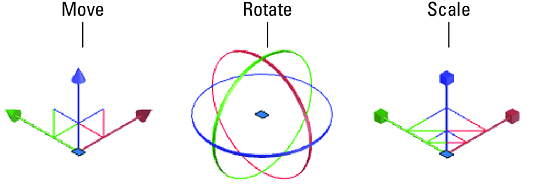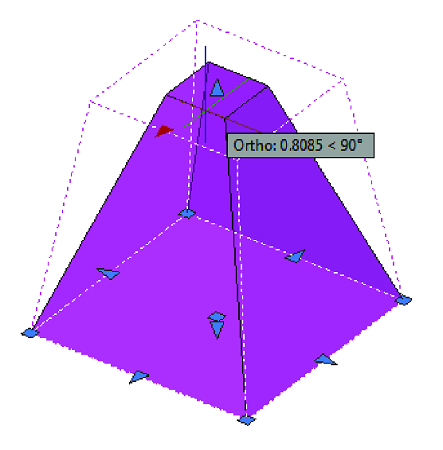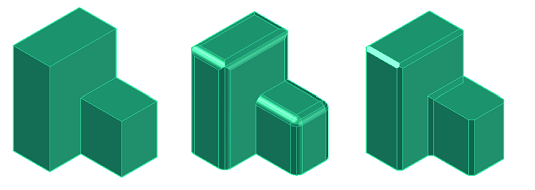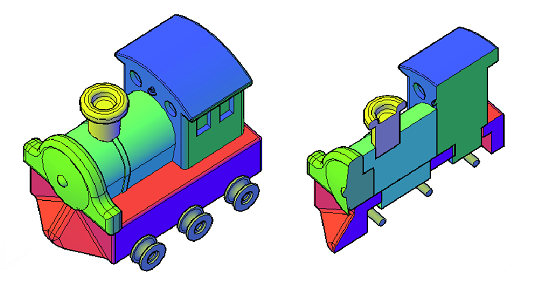Objects Only Drawing in Xy Plane Autocad
Selecting subobjects in AutoCAD
Three-dimensional objects themselves are complex objects that tin be made up of several hundred, or perhaps even thousands, of objects. Although these objects never stray from their parents, yous can access them individually or in groups via subobject selection: selecting a vertex, an edge, or a face of a 3D object. After yous select a subobject, you tin can use grip editing and the 3D gizmos to dispense it.To more easily select subobjects, you tin can enable subobject filtering from the Ribbon. Vertex, edge, and face filters are located on the Subobject Selection Filter split up push button in the Pick panel on the Dwelling house and Solid tabs.
The CULLINGOBJ and CULLINGOBJSELECTION system variables help limit object selection to the faces that are visible in the electric current view past ignoring faces around the back of the objects being viewed. By default, both these variables are turned off, so y'all can select objects in front end and behind. If you have a circuitous model, plow on alternative by clicking Culling in the Selection panel on the Dwelling house tab. To turn off culling, click the Alternative button over again. The button is shaded blueish when the feature is enabled.
If y'all need to select only a confront on a 3D object, press and concur the Ctrl central and select the face you desire to select. This method tin be faster than turning subobject filters on and off.
Working with gizmos in AutoCAD
Although you tin can utilise the Move, ROtate, and SCale commands to modify 3D objects, they tin can sometimes give unexpected results in 3D. Enter the 3DMOVE, 3DROTATE, and 3DSCALE commands, which all use a gizmo or grip tool when a not-orthographic view is current.  Using gizmos to alter AutoCAD objects in 3D.
Using gizmos to alter AutoCAD objects in 3D.
A gizmo restricts or constrains motion forth the X,Y aeroplane and the Z-centrality. To use a gizmo, click an axis on the tool to restrict movement to that centrality. You can access the 3 gizmos past using these methods:
- 3DMOVE: Click 3D Move in the Change panel on the Home tab, or type 3DMOVE at the command line.
- 3DROTATE: Click 3D Rotate in the Alter panel on the Home tab, or type 3DROTATE at the command line.
- 3DSCALE: Click 3D Calibration in the Modify panel, or type 3DSCALE at the command line.
You can too access the Move, Rotate, and Scale gizmos in 3D by selecting objects when no command is active. You can set the default gizmo that is displayed when you use grips in 3D by opening the Gizmo drib-downward carte du jour in the Selection panel on the Home tab and selecting the gizmo that you want to be active. Correct-clicking a gizmo lets you switch betwixt different gizmos and constraints.
More 3D variants of 2nd AutoCAD commands
Moving, rotating, and scaling objects are certainly the Big Three operations of 3D editing, but a number of other 3D variations on second editing commands are hiding in the wings, awaiting their turns in the spotlight.Getting your 3D AutoCAD ducks in a row
Making objects align with each other in 3D can be a challenge at times, specially if y'all need to not only move an object in 3D but as well rotate and scale it based on the specified alignment. AutoCAD has two commands you lot can use to align objects:- Marshal: Used to align 2D and 3D objects based on 1, ii, or three pairs of points. Based on the number of pairs of points that are specified and how they're selected, the Align command might motion and rotate the selected objects into identify. Information technology tin can too be used to scale objects. On the Abode tab, choose Align from the Modify panel slideout.
- 3DALign: An improved version of the Align command that includes additional options too as the ability to movement and rotate a copy of the selected objects and use Dynamic UCS with the command. Click 3D Align in the Alter console on the Home tab.
Holding upwardly a mirror
The MIrror command is limited to working on the X,Y plane. If you want to mirror objects in 3D, yous utilize the MIRROR3D control. Click 3D Mirror in the Alter panel on the Home tab. The MIRROR3D command is similar to the MIrror command, but you lot can control the plane on which the mirroring is performed.The generic 2D MIrror command works also in 3D, but you lot must employ a trick. As indicated in the preceding paragraph, MIrror works merely in the X,Y plane — but it doesn't have to be the Globe X,Y plane. The command works as well in the X,Y plane of the current User Coordinate System (UCS).
Associative arrays work in 3D equally well as in 2D. AutoCAD has long had the 3DARRAY command; information technology's similar to the old-style Assortment command in that it doesn't create an associative array object. For information on creating rectangular, polar, and path assortment objects, refer to the online Help organization.Editing solids in AutoCAD
You lot tin edit 3D solids in a variety of dissimilar ways that you lot tin can't edit other objects. Yous tin use grip editing to change the shape of 3D solids, or apply Boolean operations on a 3D solid to create complex models. You can fillet and chamfer the edges of a 3D solid by using the FILLETEDGE and CHAMFEREDGE commands.Using grips to edit solids
Grip-editing is one of the almost direct ways to modify an object. To edit a 3D solid past using grips, select the 3D solid when no command is running, and and so select the grip that you want to use to edit the solid. Pay close attention to the grip y'all select; some grips give you command over changing the overall size of a solid; others might change simply office of a solid, such as the face or top radius of a cone.  Grip editing a pyramid.
Grip editing a pyramid.
Boolean operations
You can bring together 3D solids by using the UNIon control to create a new 3D solid. You lot tin as well subtract book from a 3D solid by using some other, intersecting 3D solid to determine what should be removed with the Decrease command. The INtersect command can be used to summate a new 3D solid based on the volume that is common to two or more intersecting 3D solids.Come across the image below for examples. You tin can find these 3 commands in the Boolean panel on the Solid tab.
 Solid primitives on the left, and the result of using the Marriage, Subtract, and INtersect commands.
Solid primitives on the left, and the result of using the Marriage, Subtract, and INtersect commands.
Boolean operations are probably the almost-used of the 3D commands. Yes, primitive solids such every bit a box or a wedge are piece of cake to use, but nigh real-world 3D objects are more complex than the simple primitives. Something as apparently unproblematic as a connecting rod on a machine engine might require a dozen or so Boolean operations to add and subtract simpler solids until you arrive at the final pattern.
You volition often need to change to a different user coordinate arrangement (UCS) before placing the next subobject to be combined with the base object. The easiest fashion to practice this is to plough on UCSDETECT (F6) on the status bar. Then, every bit you move the cursor effectually while a create command is active, AutoCAD volition automatically snap the UCS to any planar surface that information technology passes over.
Filleting and chamfering
Considering fillets and chamfers are common real-world features, information technology's logical that tools for creating them are available. You can fillet or bevel the edges of a 3D solid by clicking the Fillet Edge (or Chamfer Border) split button in the Solid Editing panel on the Solid tab.Both commands let you to select multiple edges to fillet or bevel. When you select an edge, AutoCAD gives yous feedback on how the selected edge will be affected. The following image shows an L-shaped 3D solid that has been filleted and chamfered.
 Earlier and afterwards filleting and chamfering a 3D solid.
Earlier and afterwards filleting and chamfering a 3D solid.
To remove a fillet or chamfer, start the Erase command. Then, at the Select Objects prompt, hold down the Ctrl key and select the fillet or chamfer to be removed. For fillets, you may need to besides remove nearby filleted corners that might have been created during the application of the fillet.
The FILLETEDGE and CHAMFEREDGE commands were new in AutoCAD 2011. You can still employ the Fillet and CHAmfer commands on 3D solids, but the new commands are much more efficient.
Slice
The Piece command lets you lot cut a 3D solid along a plane. You lot can slice a 3D solid past using a planar curve, such equally a circle, 2D polyline, or surface, amid many others. When you slice a 3D solid, you can choose which part of the 3D solid is retained, or you can keep both. This prototype shows a solid model that has been sliced in half.  Carving up a solid model with the SLice command.
Carving up a solid model with the SLice command.
To start the Slice command, choose Slice from the Solid Editing panel on the Solid tab. Subsequently the command is started, specify a 3D solid to piece, an axis or object to define the cutting plane, and so, finally, which new 3D solids to keep.
Use this guide to uncover more than AutoCAD secrets.
Source: https://www.dummies.com/article/technology/software/design-software/autocad/autocad-commands-for-modifying-and-editing-3d-objects-264956/
0 Response to "Objects Only Drawing in Xy Plane Autocad"
Postar um comentário